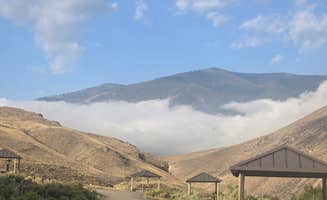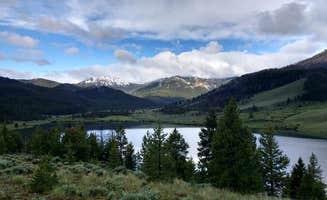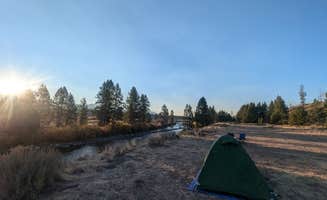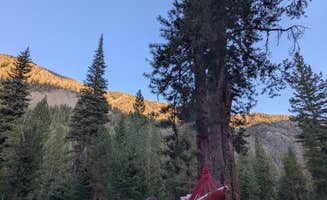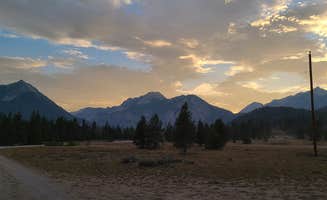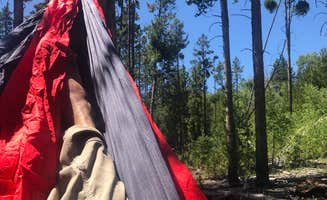Primitive camping near Clayton, Idaho offers varied terrain along forest service roads branching from Highway 75 into the Sawtooth National Forest. The area sits at elevations between 5,000-7,000 feet with summer temperatures often dropping into the 30s at night, even in July and August. Most dispersed sites remain open from late spring through early fall, with winter snowpack limiting access from November through April.
What to do
Fishing access: Deadman Hole Recreation Site provides direct access to the Salmon River with a boat launch for various water activities. "Boat launch for rafting, kayaking, fishing," notes camper Nancy C., who also mentions the site is just "an easy drive to Challis for supplies."
Hiking trails: Several trails lead to alpine lakes in the surrounding mountains. Near North Fork Big Wood River dispersed #5, "lots of great hiking at the trailheads near this campsite" with the "North Fork of the Big Wood River with the sound of churning water" creating a peaceful backdrop according to Mike E.
Stargazing opportunities: The minimal light pollution creates excellent conditions for night sky viewing. Deadman Hole offers "serious star gazing opportunities" according to one camper, while sites at higher elevations provide even clearer views. Kevin C. noted the "unparalleled astronomy night viewing" available at dispersed sites with "clear views all around."
What campers like
River proximity: Many campers value the easy water access. At Decker Flats Dispersed, one camper found "a perfect spot" describing it as "super beautiful right inbetween burned and pristine forest on the river. Close enough to Stanley but still a world away."
Wildlife viewing: The area supports diverse wildlife populations. Near Challis, one camper reported seeing "mama moose and twin babies" despite visiting during July heat when they still enjoyed "77 degree days and cool breezes."
Spacious sites: Redfish Lake Overflow Dispersed offers well-defined camping areas with adequate space. According to Mark, "The left side is better for solar with larger spots," and notes the area has "spots marked with large stones" on recently updated roads with "packed sand like substance."
Quiet atmosphere: Many campers report peaceful conditions despite proximity to roads. At the North Fork Big Wood River site, "if you venture 3 to 4 miles in it's very quiet and peaceful" with the bonus of being "wooded forest experience" near Sun Valley.
What you should know
Weather preparedness: Mountain weather changes rapidly, even in summer. At North Fork Big Wood River, Mike E. warns "weather can change on you rapidly and strongly. Be prepared" since you're "in a valley without a lot of visibility far out to the weather."
Road conditions: Some forest roads require high-clearance vehicles. For Nip and Tuck Rd - Dispersed Camping, Ray & Terri F. advise: "do not come in from the East on NF-633/Nip and Tuck Road off of Hwy 75 as just a short distance in, there is deep and narrow wash across the road that will likely ruin the underside of your RV unless you have a very high clearance vehicle."
Cell service limitations: Coverage varies dramatically by location. At Nip and Tuck Road, "only a few [sites] facing Stanley have cell service," though in those spots "AT&T service was fair with 2-3 bars of LTE and speeds up to about 1.5 MB/s. T-Mobile service was good with 3 bars of 4G/LTE."
Seasonal availability: Most primitive sites near Clayton follow Forest Service restrictions. For Decker Flats, the season runs "March-October (Year Around Access)" though other areas may close earlier due to weather.
Tips for camping with families
River safety awareness: The Salmon River currents can be strong in spring and early summer. One camper visiting Salmon River - Dispersed Camping mentioned it was "right on Salmon River, really lovely" but noted it was "a bit close to the highway."
Toilet access consideration: Some dispersed areas offer vault toilets while others have none. At Redfish Lake Overflow, Richard C. noted "the vault toilet was very clean" and the entire "campground was right off the highway" with "traffic noise during the day, but pretty much quiet at night."
Insect preparation: Bugs can be an issue, especially near water. Ray & Terri F. reported "a few flies around during the daytime, but not the biting kind, just annoying. Mosquitos were an issue only in the evenings."
Temperature fluctuations: Pack layers for dramatic day-to-night changes. Mark observed at Redfish Lake Overflow that "Weather was beautiful (70s) during day and low 30s to high 20s at night" in mid-September.
Tips from RVers
Site selection strategy: Arrive early for better choices, especially on weekends. For Nip and Tuck Road, campers recommend driving "about 3 miles in" to find the "best spots" with panoramic views of the Sawtooth Range.
Leveling requirements: Many sites require significant leveling for larger rigs. Ray & Terri F. found their site "sloped a bit from side to side, but we were able to get mostly level" in their "36 ft Class A with a Cherokee Trailhawk tow."
Resource management: Plan for complete self-sufficiency. Mark noted that "Potable water and dump at both Redfish Lake and Stanley Ranger station. Both areas are $12 and both a short drive. Dumpsters at both locations."
Generator etiquette: Be mindful of noise in popular areas. Mark gave a "4 rating [for Redfish Lake Overflow] because of road noise and generators (including open frame) running nonstop over the weekend."


